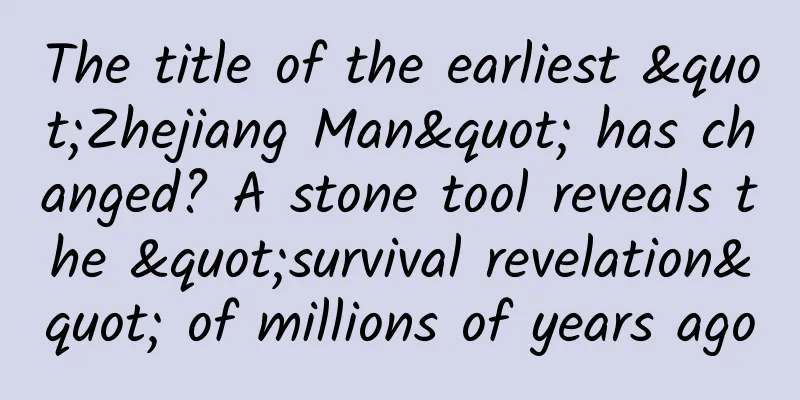The title of the earliest "Zhejiang Man" has changed? A stone tool reveals the "survival revelation" of millions of years ago

|
When talking about the earliest human life in Zhejiang, for a long time, it was represented by "Jiande people". However, in 2004, a stone tool from Si'an Town, Changxing, Huzhou, changed this view. In 2004, archaeologists collected a flint scraper in Si'an Town, which led to the discovery of the Qiliting site. This groundbreaking discovery filled the gap in Zhejiang's one million-year human history. According to paleomagnetic measurements, the earliest age of the Qiliting site is about 1 million years old. Zhejiang people have since known that 1 million years ago, ancient humans were living and multiplying on the land of Zhijiang. A blessed land: an ideal habitat for early humans I visited the Qiliting Ruins in Changxing, Huzhou, on an autumn day after the rain, with the air filled with the faint fragrance of osmanthus. Going west from Changxing along the shore of Taihu Lake, the Hangzhou-Changsha Expressway and the Shanghai-Chongqing Expressway intersect through the Si'an hub, and the Qiliting Ruins are near the intersection of the two highways. "The site is just ahead, less than 100 meters from where we are now." Xu Xinmin, a researcher at the Zhejiang Provincial Institute of Cultural Relics and Archaeology, who was the leader of the Qiliting site archaeological excavation project, said. Looking in the direction of his finger, the site excavation pit was sandwiched between the highway and the hub ramp, and we could only watch from behind the highway fence and layers of green plants. "Although we can't walk to the side of the pit, I believe that the land we are standing on also has the marks of the ancient people's lives millions of years ago." Xu Xinmin comforted the reporters who were unable to reach the side of the site pit. What should the land under our feet look like millions of years ago? "At that time, the area around the Qiliting site should have been a 'blessed land' with dense forests, sufficient water sources, abundant food, and protection from floods and droughts, providing an ideal habitat for early humans to gather, fish and hunt," said Xu Xinmin. The highway that blocked the reporters' visit to the site was an opportunity for human relics from a million years ago to be seen by the world. In 2005, in order to cooperate with the construction of the Hangzhou-Changxing Expressway, the local government officially launched a cultural relic exploration survey. The Zhejiang Provincial Institute of Cultural Relics and Archaeology and the Changxing County Museum jointly carried out rescue archaeological excavations at the Qiliting site. Source of the excavated stratigraphic cross section: provided by the interviewee From September 2005 to May 2006, archaeological team members peeled away the soil layer by layer and discovered 19 stratigraphic accumulations at the site. The deepest layer excavated reached 12.5 meters from the surface. A total of more than 800 stone tools were unearthed. Today, some of the stone tools are stored in the Changxing Taihu Museum. In the modern building, people can see the history of millions of years at a glance. Hand picks, hand axes, choppers, scrapers... In the "Evidence of Zhejiang's Million Years of Human History" exhibition hall on the second floor, ancient stone tools are quietly displayed behind glass cabinets. Xu Xinmin knows these ancient relics like the back of his hand: "These stone tools are equivalent to modern people's axes, shovels, knives and hammers. For early humans, they can be used for chopping, cutting, drilling and digging, etc., which are tools that make daily life more convenient." A piece of stone: scientific wisdom hidden in its meticulous craftsmanship What kind of daily life of early humans is hidden in these stone tools? Perhaps one morning, the old and young women and children living in Qiliting were collecting wild fruits in the woods, while the young and strong laborers were holding stone tools and heading to the nearby hills to look for prey. Perhaps on the hills, they were lucky enough to find a broken piece of elk flesh and bones, which were the "remains" left after some ferocious beast had just had a full meal. The ancient humans happily took it back to the woods. Perhaps ancient humans were already able to use fire. When evening came and it got dark, they lit a fire, used scrapers to cut the meat they had obtained during the day, roasted it over the fire, and shared the delicious food with their companions. "At that time, ferocious beasts were rampant on the earth, and it was not easy for ancient humans to survive. Stone tools were important tools for obtaining food and defending against attacks by wild beasts." Xu Xinmin said, and the reporter's thoughts were also brought back. Stone tools on display in Changxing Taihu Museum (Photo by Zhao Yiqiao, Chao News) These seemingly ordinary "stones" actually contain the profound wisdom of the ancients. At the Changxing Taihu Museum, archaeological restoration expert Mei Yalong said that to make stone tools, finding the right stone is a prerequisite, and different tools require different shapes. With the material, you also need to find the right striking point when making it, and be steady, accurate, and ruthless, with just the right amount of force, so that you can make a satisfactory stone tool. "The most important thing is to use clever strength." "These may seem very clumsy in the eyes of modern people, but the skills mastered by the ancients in making and using stone tools were the pinnacle of science at the time," said Xu Xinmin. "The ancient humans in Qiliting had a basic understanding of the manufacture and use of stone tools," said Chen Jiaxin, a graduate student in archaeology at Zhejiang University who accompanied the visit. "Through archaeology, we were able to 'encounter' the ancient humans across millions of years and analyze the past of this land." Inside the museum, tourists often stop to look at the stone tools through the glass. It seems as if ancient humans were making stone tools millions of years ago in front of them, preparing for the next hunt... Dialogue with archaeologist Xu Xinmin The technology in the Stone Age has an impact today The development of the Stone Age marks the beginning of human civilization and the beginning of science and technology in the broadest sense. More than 800 stone tools, including stone cores, stone flakes, choppers, scrapers, and pointed tools, were unearthed at the Qiliting site. According to paleomagnetic measurements, the earliest remains at the site can be as old as 1 million years ago. What scientific connotations are contained in the unearthed stone tools? What enlightenment do they have for modern human life? Xu Xinmin, an archaeologist at the Qiliting site in Changxing and a research curator at the Zhejiang Provincial Institute of Cultural Relics and Archaeology, is a guest on this issue of "Science in Zhejiang Culture". Question: When excavating the Qiliting site, how did you determine the age of the stone tools? A: We mainly distinguish the cultural layers of the unearthed layers based on the color, texture, and inclusions of the soil. In addition, we can preliminarily determine its age based on the characteristics of the soil layer itself. The age of the stone itself does not represent the actual age of the stone tool, so the specific age of this stone tool is mainly determined by paleomagnetic measurement. It took more than a year to determine that it was a million years old. The scene of taking soil samples for paleomagnetic dating Source: provided by the interviewee Question: Why did humans in ancient times produce stone tools in large quantities? Answer: The shape of stone tools reflects human thoughts and intentions, but ordinary stones in nature do not have any human will attached to them. The stone tools made by ancient humans were not ornaments on the shelf, but an extension of the hand function, in order to obtain food more effectively and prolong life. To determine whether a stone is a stone tool, first of all, we need to see whether it is comfortable to hold and use. The weight should also be appropriate, not too heavy, otherwise it will be difficult to hold. Stone tools need to assist humans in cutting, scraping, digging, chopping, etc., and without a reasonable and standardized blade shape, it is difficult to do so. Scrapers unearthed from the Qiliting site in Changxing Source: Provided by the interviewee Therefore, in response to the needs, humans have made scrapers, notches, hand picks, hand axes, choppers and other types of stone tools. For example, a scraper is a tool that has a cutting edge on one or both sides of the thinner edge of the blank, so that it can cut animal meat, scrape wooden sticks, etc. Question: What scientific implications does the emergence of stone tools contain? A: Not all stones can be made into stone tools. People at that time also used certain knowledge to select stones suitable for making tools. They selected stones with a hardness of 6 to 7 on the Mohs scale, which are more common in nature and easier to process into stone tools. In addition, they also avoided those fragile or soft rocks to ensure that the selected stones could be effectively used. The ancients not only used local materials, but also brought suitable stones back to the camp for processing to avoid wasting energy on stones that were inappropriate or unsuitable for making tools. When selecting and processing stones, they not only considered the hardness of the stone, but also made the shape and angle of the required tools according to actual needs. For example, if the stone is not processed with a blade, it cannot cut meat, and it must be thinned to achieve the cutting function. It contains the most basic scientific principles, which was the pinnacle of science for humans millions of years ago. Q: What insights can we gain from the living tools of ancient humans for modern humans? A: There is no easy pie in the sky. Ancient humans had to fend for themselves by collecting wild fruits and hunting animals. In order to obtain food more conveniently, artificial tools were created. All of today's daily behaviors and technologies of human beings originate from ancient times. The tools used by humans, such as fishing, shoemaking, sewing clothes, etc., can all be traced back to their origins. These discoveries explain the long process of human evolution from primitive tool use to modern technology, and demonstrate human curiosity about their own origins and the inevitability of scientific and technological progress. By tracing back to the ruins, we can have a deeper understanding of the origins and evolution of human beings themselves. |
>>: Can the eye axis be shortened? Can myopia be reversed? They are all true! But...
Recommend
If you want to lose 10 pounds before summer, start eating like this now!
As the temperature rises day by day, everyone'...
In a mobile Internet company, what are the KPIs of each department?
KPI, or key performance indicator, is a performan...
Tik Tok follower growth trend in 2021!
At the beginning of every year, short video creat...
With advertisements in the European Cup, can CATL, which aims to become the Intel of the automotive industry, gain strong control over car manufacturers?
On June 14, the European Cup, which was pessimist...
iOS 15.4 released: What's new in iOS 15.4
iOS and iPad OS 15.4 are huge updates that bring ...
Let's talk about the data interaction and protocol between the front-end and the back-end
[[161047]] At present, except for some very simple...
Nintendo's big bet after a decade, but this time the Switch may not win
I still remember that in 2004 and 2006, facing th...
China Passenger Car Association: China's global auto market share will rise to 41% in December 2024, a record high
According to recent news, the latest data release...
Evaluation of 16 paper towels: An unknown brand with monthly sales of over 100,000 pieces is actually more expensive than Depot and Nepia?
Every time Double Eleven comes, the must-have is ...
How can brands take advantage of the Qixi Festival? Here are 6 marketing tips for you!
What are some heartfelt entry points to leverage ...
Action sci-fi movie "Ready Player One" HD 1080P with Chinese and English subtitles
The story takes place in 2045, and virtual realit...
Parse Tutorial: Network Backend Basics
[[141390]] This tutorial has been updated for Swi...
7 simple ways to quickly understand user dads through online data
No matter what kind of marketing we do, we need t...
Snapdragon 820 vs. Exynos 8890: Which one is better?
Preface: Apple A9 and HiSilicon 950 are not within...









